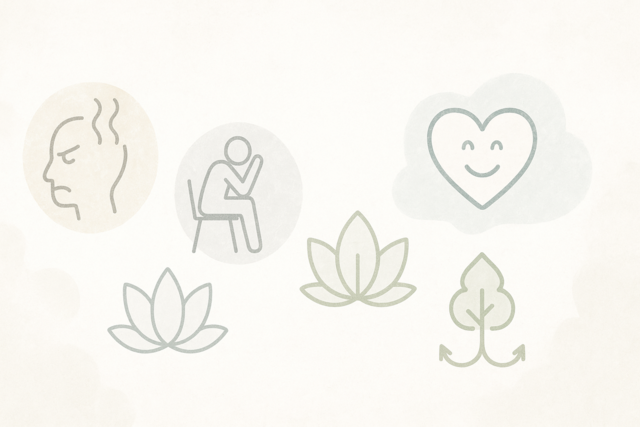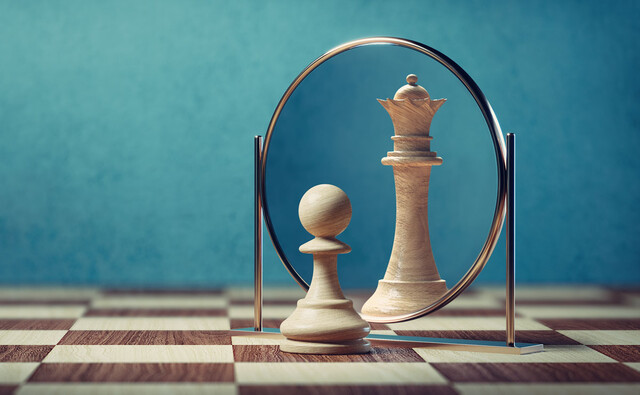Sound Therapy
-
Music
-
Nature
-
White Noise
By applying Mindfulness to every relaxation intervention, you will bring greater power to the application and achieve greater results than you might have otherwise reached.
As we discuss the various methods of sound therapy, visualize how you normally listen to sounds or music. Do you pay attention to the sounds, or do you allow them to become part of the background as you are busy doing other things? Can background sounds help to relax you as you go about your day?
Sound therapy is very subjective; what works for one person may not work for someone else in exactly the same way.
Music
Music speaks to our soul. Without music, most of us feel that life would be very dull. Have you ever evaluated what music actually does for you, personally? From the beginning of time, music has played a very important role in healing. As a communal activity, music and medicine have been inextricably linked. According to the ancient Greeks, "Music is an art imbued with power to penetrate into the very depths of the soul."
Deepak Chopra expressed the power of music quite beautifully, "Where is music? You can find it at many levels in the vibrating strings, the trip of the hammers, the fingers striking the keys, the black marks on the paper, or the nerve impulses produced in the player brain. But all of these are just codes; the reality of music is the shimmering, beautiful, invisible form that haunts our memories without ever being present in the physical world."
Some scientists believe that there is a direct link between what a person thinks, believes, and perceives and their immune system. As a result, this means that we can proactively affect our health with the appropriate use of music.
What can music do for us? It inspires us, relaxes us, energizes us. It can be a classical symphony, or it can be a piece that takes you back to a very special, happy time. Many world cultures use the music of chanting and toning in their healing ceremonies. While you may not feel comfortable learning to chant or tone, recognizing that music is a form of ancient healing will help you to notice how music affects you.
By being aware of your response to music, you have power over how you feel overall. Music helps us to move beyond the daily state of consciousness and allows us to return to a time in our past where we remember good and blissful feelings, or it can be used by our imagination to bring those feelings of the past to the present moment and allow us to relax.
Stress, as you have learned, is a killer. Learning to manage stress leads to an improved capacity for living a happy and contented life. By incorporating music into your relaxation protocol, you now have the capacity to return to a time of true peace or bliss, just as Siddhartha did. You're not going back in the past, as you know from your study of mindfulness, this is not the goal. However, reaching a moment in your past where you experienced true peace and bring it into the present moment is a great step toward your relaxation exercises.
The American Music Therapy Association has more than 70 schools in the United States that provide alternative therapy to individuals who are looking for a natural method of healing. Barbara Crowe, the past president of the National Association of Music Therapy believes music is healing because it calms the chatter in our brains. Other doctors believe that music helps people to heal faster by allowing them to accept their condition without judgment - exactly what you learned about the practice of mindfulness.
Obviously music is entraining, and can momentarily transport us. You've already considered how music might bring back memories of a time past. When this happens, we are responding to the environment created by music. Using music is a powerful behavior modification tool. Note, however, that music can have either a positive or a negative effect on you. It is for you to make note of your response to music.
Music touches a person at all levels of consciousness, healing the body by having a positive effect on the nervous system and the endocrine system. Music is also used as a diversion, taking our attention away from something that is bothering us, or is painful to us. Many birthing centers suggest that expectant mothers and fathers bring soothing music, music that they like and respond to well with them during labor and delivery. By using music that is especially healing to them, the experience of pain and anxiety is greatly managed.
Research has proven that humans respond physiologically to music. Music played in higher registers and at greater than 80 to 90 beats-per-minute will increase tension and anxiety. Music that is played in the lower registers, and at about 40 to 60 beats-per-minute will decrease tension.
Without actually hiring a music therapist, you can make good use of music in your relaxation practice. Make a list of music that profoundly moves you in your notebook. Now, note next to each piece of music what it is about that piece of music that is meaningful to you.
Your next job is to separate the music into "fast" versus "slow" music. Faster music increases tension. But remember, not all tension is bad. If you're looking to go for a walk, run, or workout on your bicycle, using faster music will energize you and make your workout less painful. Exercise has a very important role in your relaxation exercises, so you might make a playlist of music that is energizing for your workout sessions.
Now, make a playlist of music that is meaningful to you, but is more slow, deep, and soothing in sound. This is the type of playlist you want to have available when you are practicing your relaxation exercises. Sometimes music that is healing works on our emotions, helping us to deal with grief, despair, and sadness. When we allow ourselves to experience these emotions without judgment, we are allowing ourselves to heal and as we heal, the uncomfortable feelings will dissipate.
By avoiding our emotions, they build up inside of us. When things build up, we are not healing. Instead, we are adding to our stress level, even when we don't realize it. By not dealing with our negative feelings and emotions we hold onto them and they never go away.
One of the most powerful "sound therapy" methods is to use the sounds of nature to calm and soothe. Many babies sleep better when they hear recordings of water, whether it is a river sound, ocean waves, or rain. Many adults are now recognizing the benefits of listing to sounds of nature as part of their daily relaxation practice. Research has shown that altering our brainwaves, other body functions change as well like our breathing and heart rate. These can be changed by listening to soothing sounds of nature. Sound therapy is very helpful in counteracting or preventing the damage that chronic stress does to our bodies. Not only will you learn to relax, but you will heal.
Your state of mind affects your health. By bringing about a more positive state of mind, you can keep anxiety and depression at bay by preventing our stress response from getting out of control.
Environmental sounds are soothing to the great majority of people, but the sound must be one that is relaxing to you. One person might have a great terror of thunderstorms, so listening to a recording of a thunder/rainstorm would not bring about the desired response for that individual, but for one who loves the sound of thunderstorms, they might use that as their nightly ritual to go to sleep and they will experience deeper and more sound sleep.
Sound therapy is very personalized.
What sounds affect you in a positive way? What sounds bring back good memories and make you feel peaceful and content? Make a note of your answers in your notebook. See if you can find recordings of these types of sounds that are especially pleasing to you. Many such recordings are available for download off the computer, some of them are free; others are available for a very minimal cost, less than a dollar from such places as iTunes and Amazon music.
Recent studies have demonstrated that nature has a greater impact on our ability to relax than previously thought. Walking in nature provides greater levels of relaxation than walking in a busy city environment. If you can't find a natural place to walk, perhaps a park, or along a river or lake, listening to the recording of a natural sound is an excellent alternative.
White Noise
White noise is sound therapy, but unlike music or an environmental sound, white noise is designed to distract the brain from listening carefully to other sounds that might be interfering with an individual's ability to sleep or concentrate. Again, recordings of white noise such as the hum of traffic or steady surf or rain might work as a good white noise distraction for you. Other people find that the use of a fan or an air conditioner provides the necessary distraction so that they are able to block out distracting noises that raise their stress level.
For some people with a condition called tinnitus, using a white noise generator can allow them to relax enough to get some sleep. Tinnitus is a chronic ringing in the ears, something that can be caused by a number of things. Most sufferers of tinnitus can move about their daily activities without too much difficulty, but when it comes time to sleep, the constant sound in their ears makes it difficult to relax enough to go to sleep. For these people white noise can provide the necessary brain distraction for them to sleep.
Meditation
-
It's Not What You Think
-
Lying Down Meditation
-
Sitting Meditation
Meditation, especially mindful meditation, is not something to undertake lightly or half-heartedly. If you are really interested in pursuing a more relaxing and stress-free lifestyle, incorporating these techniques will not work if you do them without intent.
Mindful meditation requires you to be in the present moment as much as possible during your meditation exercises. It is not a time to think about how to solve a problem at work, or what you're going to say the next time you talk to your mother or your brother. It isn't the time to plot out revenge against a neighbor who keeps letting their dog bark all night. Mindful meditation is going to require that you be fully present for each meditation session.
If you're not ready for mindful meditation then you might be better off looking at one of the other methods of relaxation in these lessons. For those not ready, any time spent in meditation practice will be painful and a waste of time. This is not to say that you can't try it, it is just that by "expecting" something out of meditation, you are likely to be disappointed.
For those of you, however, who are ready and able to open your minds and hearts to give such an experience a chance, this will be virtually life-changing for you. The key is to approach meditation without expecting a result.
Meditation, It's Not What You Think
Unless you've had some experience at meditation, you could end up being very surprised by the end of this lesson. Meditation is not a technique to be learned or a position to use. Meditation is a way of being.
There will be certain meditations that use various techniques or positions, but meditation in and of itself is a way of being. It is how you come to it that matters. Learning to meditate is the quickest and surest ways there is to learn to be in the present moment. Some of us are so goal-oriented that we want to learn the techniques, then check it off our list as something we've accomplished. You may be successful in learning the techniques, but you will have missed the lesson in "being."
Meditation is not relaxation.
You can become relaxed by using meditative techniques, but mindful meditation requires that we notice what comes to our mind, things that come up, whether they are problems, pain, tension in our body, boredom, impatience, frustration, or anxiety. What we do with those things we notice is to accept them without judgment, allow ourselves to have deeper insight, and then move on. There is no "succeeding" in meditation practice. It just is.
Meditation can be one of the most difficult things you ever do. It is not the development of the ability to suddenly make your mind blank. One meditation instructor who has been practicing deep forms of meditation for more than 25 years, said the longest he can go without having a thought is only a second or two. The key is to notice that you're thinking about something, and then bring yourself back to the present moment.
In meditation there is no trying. There is no succeeding. There is only being. It is the practice that brings us the benefit.
Meditative practice does not control your thoughts.
Some students, new to meditation, believe that they must learn to control their thoughts in order to have a good session in meditation. The real truth is that we come to meditation without judgment, with whatever is going on in our lives, because it just is. Learning to accept ourselves and where we are in our life at any given moment is an incredibly difficult concept for goal-oriented people.
Mindful meditation is accepting yourself at a given moment for who and what you are, practicing your meditation with your heart and mind focused on the present moment. You're not trying to get anywhere. It is about being just who you are, where you are in the world.
This may be one of the most difficult things you have ever done. Our minds resist allowing things to just "be," if even for a single moment. Our meditation practice becomes even more difficult when we begin to believe that by meditating we will change the course of our lives and make what is wrong in our life better.
You can certainly want to see changes. But the only way we can change is to let go, stop trying to control any outcome with our meditative practices and trust the process.
You may already have a meditation practice that you use and enjoy. If so, continue with that type of meditation with the focus on being mindful about your meditation practice. There is no goal, there is no winning, there is no right or wrong, it just "is."
One thing to keep in mind with a meditation practice done when lying down is the risk of falling asleep, and a lying down meditation is more about "falling awake." As you practice, you will begin to notice the times when you fall awake, become intensely aware of everything about your meditation practice.
Is falling asleep during a lying down meditation a problem? Not necessarily. If this works for you as a form of relaxation, and meditating in a lying down position allows you to sleep when you otherwise would not, you may find this to be a very beneficial practice.
However, when using meditation for the purposes of being aware, you may wish to use an alternate form of meditation.
One of the greatest benefits to meditating lying down is that most of us are able to relax more completely and fully when we are lying down. We are able to "sit still" for longer periods of time, something that is likely very foreign to us. Once you begin your meditating practice, you will find that you have two opportunities every day to do a check on yourself. The first is in the morning when you awaken, just before you arise, and then next is when you lie down to go to sleep at night. Both times you can even use as a meditation practice of even just a few moments.
When you are lying down, you can more easily perceive your breath and whether your abdomen moves up and down as you breathe, the reminder to take full breaths, expanding your lungs as fully as possible.
The best position to take when meditating lying down is to be on your back, arms at your sides, slightly away from your body. Legs are slightly apart and your toes of each foot pointing away from one another.
Some people are very uncomfortable lying down on their back. For those people, it is entirely appropriate to meditate lying face down on your stomach, or on your side, curled up in a loose fetal position. The idea is to find a position that is infinitely comfortable enough for you to be still for more than just a few moments.
What do we do when we meditate?
Meditating is the opportunity to simply "be" without judgment, without goal or plan. The first few times you meditate, you may consider simply paying attention to your breath. As you breathe, just notice your breath going in and out. It doesn't matter if it is deep or not, through your nose, or through your mouth. Every time you notice your mind wandering, bring it back to noticing your breath.
The reason breath is used as an anchor for meditating is because we breathe naturally. We can consciously control our breathing, but we cannot live without breathing. As long as we are alive, our breath is always there. Because of this constancy, noticing our breath becomes a way to meditate without our having to do anything but notice.
You may choose to only notice sounds. This is a good exercise in meditation, because sounds often jolt us out of our sense of peacefulness, and many individuals find themselves becoming irritated at sounds that seem to interfere with their ability to concentrate. Remember, meditating is to notice without judgment. If a sound attracts your attention, notice it, then return to the other sounds you hear. When you find your mind trying to make sense of the sound, return it, without judgment to simply noticing.
Many people find that they have been so absorbed in their lives that they have not noticed sounds because their brain is so full of chaotic noise, the sounds that run through your head from the moment you wake up, to the moment you finally fall asleep. It is to quiet these noises in our brain that a sound meditation has infinite power. Most people know that they do not make good decisions when the roar in their head is so loud they cannot "hear" the sounds of life around them.
Certainly, we can hear them, but we don't notice them because we're so caught up in "listening" to the sounds in our head. If this is what troubles you, the noise in your head, try meditating by listening to and noticing sounds around you. Each time you notice your thoughts turning to something other than listening, return it gently, and without judgment, to listening again.
Other people gravitate more easily to a meditation where they focus their eyes on a physical object. It could be something hung from the ceiling, it could be a ceiling fan. For those of you who prefer to meditate this way, focus on the object, and when you notice your thoughts moving beyond that object, gently bring them back.
What is most important about meditation is that there is no right way and no wrong way to practice. Eyes open, eyes closed. Breathing through the mouth or the nostrils. Sometimes meditating is simply noticing our emotions and reactions to situations as long as you are not trying to figure something out. Just noticing them without judgment.
By meditating for a few minutes every morning upon awakening, and just before going to sleep at night you put yourself in the position of mindfulness, of noticing things about yourself that you never paid attention to before because your previous practice of leaping out of bed and frenetically starting your day didn't give you time to do this.
Another form of lying down meditation is the Body Scan. This is something that you can look up and try on your own. It is a meditation where you notice each portion of your body in sequence. Some people find this to be a good way to focus their thoughts on something other than their troubles and concerns. Other people find this an excellent way to relax each portion of their body where they may be holding tension. Try this for yourself and see how it fits for you.
As with the lying down meditation, the sitting meditation is another way to be in the present, in the here and now of your life, with whatever that contains. Meditating is not a way to escape the chaos that is our life, rather it is a way to "be" with it. Whatever is in the moment of your meditation is accepted without judgment and noticed.
Your meditation practice is an opportunity for you to practice true compassion with yourself. Being without judgment sounds simple enough, and it really is, yet we rarely practice it. A sitting meditation is another opportunity to meditate, to sit with yourself in the moment. It is not the same thing as sitting down to rest or relax, where your mind is focused on listening to music, or conversation, or reading a book. A sitting meditation is another opportunity for you to notice the moment and you in that moment.
By formalizing your sitting meditation, you create a sense of purpose with it. Using a very stable cross-legged sitting position on the floor is one of the most common ways to meditate. It is a comfortable and stable position, using either a carpeted surface, a mat, or a pillow to rest as comfortably and as easily as possible.
For those of you for whom sitting on the floor is not possible or comfortable, there is nothing to keep you from practicing a meditation period in a chair. This is equally valuable and as beneficial as sitting on the floor. The best chair is one that helps to keep your back straight, but again, don't get too attached to this as a requirement, what you bring to meditation in your mind is the only true requirement.
Just as with a lying down meditation, you can either choose to meditate with your eyes opened or closed, listening to music or sounds of nature, or simply listening to what is going on around you. For some, this is an especially powerful meditation, because what is going on around is already there. There is nothing for you to do to set it up, either in the choosing of what to listen to or the volume at which you choose to listen. By listening to what is going on around you, you have put yourself into the present moment simply by noticing these sounds. What sounds do you routinely hear? What sounds have you never noticed before?
While performing this meditation out in nature, you might already be aware of the sounds of the wind and trees, or the water in the form of waves or ripples. Keep listening. Do you hear the wind changing? Do you hear insects like bees humming or crickets chirping?
Notice these sounds. Notice the sound of your breathing. Notice that you've stopped noticing and have begun to think about other things, and have stopped hearing the sounds around you. Without judgment about your success or failure, return your thoughts to what you're hearing. This is the center of our concentration.
A slightly more advanced form of the sitting meditation is to expand your awareness to your body and what it is feeling. This can include noticing the temperature of your environment, whether your skin feels warm or cool. However, for many of us, we have mild to moderate intermittent or chronic pain. Perhaps you suffer from back pain, or chronic headaches. Maybe you have arthritis and your knees or your fingers ache. Just notice this. Again, without judgment, just notice it and allow it to be. There is nothing you can do about it, but notice it. Perhaps you're noticing that you have become uncomfortable in your sitting position. While it is fine to notice this and allow it to continue for a time, there is nothing to be gained if your suffering begins to interfere with your ability to meditate. There is always another opportunity to meditate.
Practice your meditations using one of your senses over another. Notice as much as you can with that sense, whether it is your sense of smell, your sense of vision seeing everything around you with eyes that are strictly in the present, your sense of touch, feeling your body, the force of the earth's gravity on it, etc. Some of you may benefit from listening to guided meditations for one or more of these types of meditations, and there is absolutely nothing wrong with using a recording to assist you in your meditation practice.



























